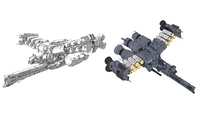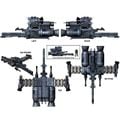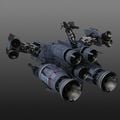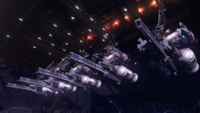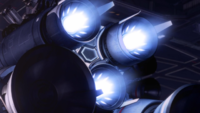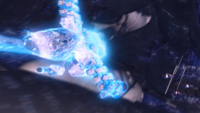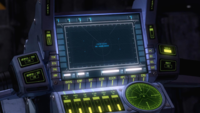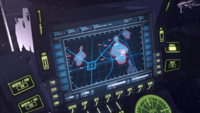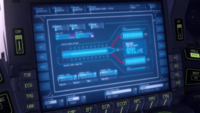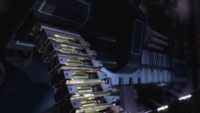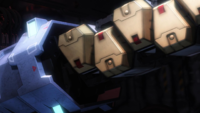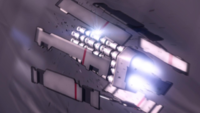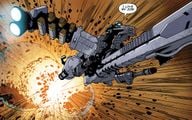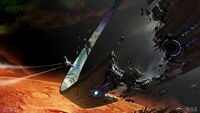OF92 Booster Frame
From Halopedia, the Halo wiki
| Open Frame 92/Extra-Vehicular Activity | |
|---|---|

| |
| Production information | |
|
Manufacturer: |
|
|
Class: |
|
|
Role: |
|
| Technical specifications | |
|
Length: |
8.1 meters (26.7 ft)[1] |
|
Width: |
3.3 meters (10.9 ft)[1] |
|
Height: |
7.6 meters (25 ft)[1] |
|
Mass: |
4.5 tons (4.1 tonnes)[1] |
|
Engine(s): |
|
|
Other system(s): |
Chaff/plasma countermeasures[3] |
|
Shielding: |
Yes[4] |
|
Armament: |
|
|
Crew: |
|
| Chronological and affiliation | |
|
Era: |
|
|
Affiliation: |
|
The Open Frame 92/Extra-Vehicular Activity[3][2], or booster frame, is an experimental space fighter in service with the UNSC Navy, developed by the Office of Naval Intelligence as a prototype.
Specifications
Design details
The Booster Frame was specifically engineered for use by SPARTAN-II units and is only usefully operable in zero-/low-G and zero-/low-atmosphere environments. It placed particular emphasis on fast, exoatmospheric engagements, where it used its high speed, maneuverability, and firepower to disrupt and overwhelm enemy warships.[2] It has no aerodynamic properties beyond its basic mass and thrust quotient.[3] Booster Frames are deployed via a specialized hydraulic winch system which extends from a ventral bay on a select number of modified UNSC warships and undisclosed ONI prowlers.[3][4]
The Booster Frame boasts a number of active protection systems. It is equipped with energy shields, which envelopes both the craft and the pilot.[4] They are also fitted with chaff launchers to disrupt plasma torpedoes. They can deploy mission-specific equipment if necessary, such as scanning devices.[4]
Armaments
The booster frame is a heavily-armed, open-frame incursive vehicle specifically intended for deep-space use and close-quarters environments. Its weapon loadout is designed primarily for "Disrupt/Overwhelm/Adapt" - a technique employed to deal with the twin problems of field-effect energy shielding and armor plating. When used in concert, the combination of EMP, explosive and projectile force can make surgical incisions in large-scale, otherwise impenetrable defenses.[3]
- 1 M92 Principle Gauss Cannon - a powerful Magnetic Accelerator Cannon that runs along the length of the booster frame. As a drawback, it requires a long time to recharge.[3]
- 12 MITV Pods - contained in the booster frame's "wings". These pods contain numerous small missiles, capable of inflicting heavy damage upon Covenant shields and starship hulls alike.[3]
- 2 80mm ball-mounted rotary cannons - mounted on the undersides of the booster frame's "wings".[3] These are the weapons most often utilized in combat.[2]
- 1 M41 ELAAGat - Extended Light Anti-Aircraft Gun firing gas-jacketed armor piercing depleted uranium rounds. Contained within the rear part of the frame, this turret is capable of being operated by another soldier who can stand at the back and provide covering fire for the pilot. The turret is a variation of the M41 Vulcan Light Anti-Aircraft Gun, designed to be operable in vacuum. It fires shells with pressurized atmospheric contents to ensure an explosive percussion in a vacuum or other challenging environment.[3]
History
The OF92 Booster Frame was developed by the Office of Naval Intelligence's Watershed Division[1] in conjunction with Naval Special Operations and the University of Songnam. As evidenced by its open cockpit design, it was developed alongside the MJOLNIR project and in tandem with the research done on EVA, or extra-vehicular activity technology following the Summa Deep Space Incident. As with many ONI projects, both the analysis and eventual matériel response were heavily classified. Because their overall cost clashes with their expendable nature, neither ONI nor the UNSC have no plans for widespread application or production.[3] In fact, it is technically classified by the UNSC Navy as spacecraft ammunition rather than a spacecraft.[2]
Because Booster Frames can only be used by fully-armored Spartan supersoldiers, their deployments are often heavily classified,[2] and during the Human-Covenant War there are only two officially recorded missions where their use has been logged.[3][Note 1] Five were used in 2544 by SPARTAN-II supersoldiers during Operation: WARM BLANKET, an assault on a Covenant fleet in an attempt to board a ship and recover the captured Dr. Catherine Halsey. During the mission, the Booster Frame showed to perform extremely well against Covenant Type-31 Seraphs, although all five were destroyed.[4] In 2558, five were used by Fireteam Majestic and Spartan Sarah Palmer during the Ambush at Oth Lodon.[5][6]
Gallery

|
Browse more images in this article's gallery page. |
Concept art from The Package.
Rear view of the Booster Frame's fusion engines.
The control panel receiving a reading from the scanning device.
The control panel showing the total charge for the Gauss Cannon.
Gabriel Thorne's Booster Frame pursuing a Sangheili Ranger on the cover of Halo: Escalation #5.
Anthony Madsen enjoying his Booster Frame.
Design sheet for the MEGA Brands Halo Toys Booster Frame, submitted to 343 Industries for approval.
Early concept art for Halo Infinite depicting a booster frame amid the wreckage of Installation 07.
List of appearances
- Halo Legends
- The Package (First appearance)
- Halo: Escalation
Notes
- ^ The Halo Waypoint article which stated this fact was written in 2009, during which time no post-war-era media had yet been written. Given the Booster Frame's continued service in the years since, it is likely this fact only applies to SPARTAN-II Booster Frame deployments during the war.
Sources
- ^ a b c d e f g h Halo Encyclopedia (2022 edition), page 161
- ^ a b c d e f g h i j k Halo Encyclopedia (2009 edition), page 266
- ^ a b c d e f g h i j k l m n Halo Waypoint (Xbox 360 app-only), Booster Frame [archive]
- ^ a b c d e f g Halo Legends - The Package (animated short)
- ^ a b Halo: Escalation, issue 5
- ^ Halo: Escalation, issue 6
| ||||||||||||||||||||||||||||||||||||||||||||||||||||||||
